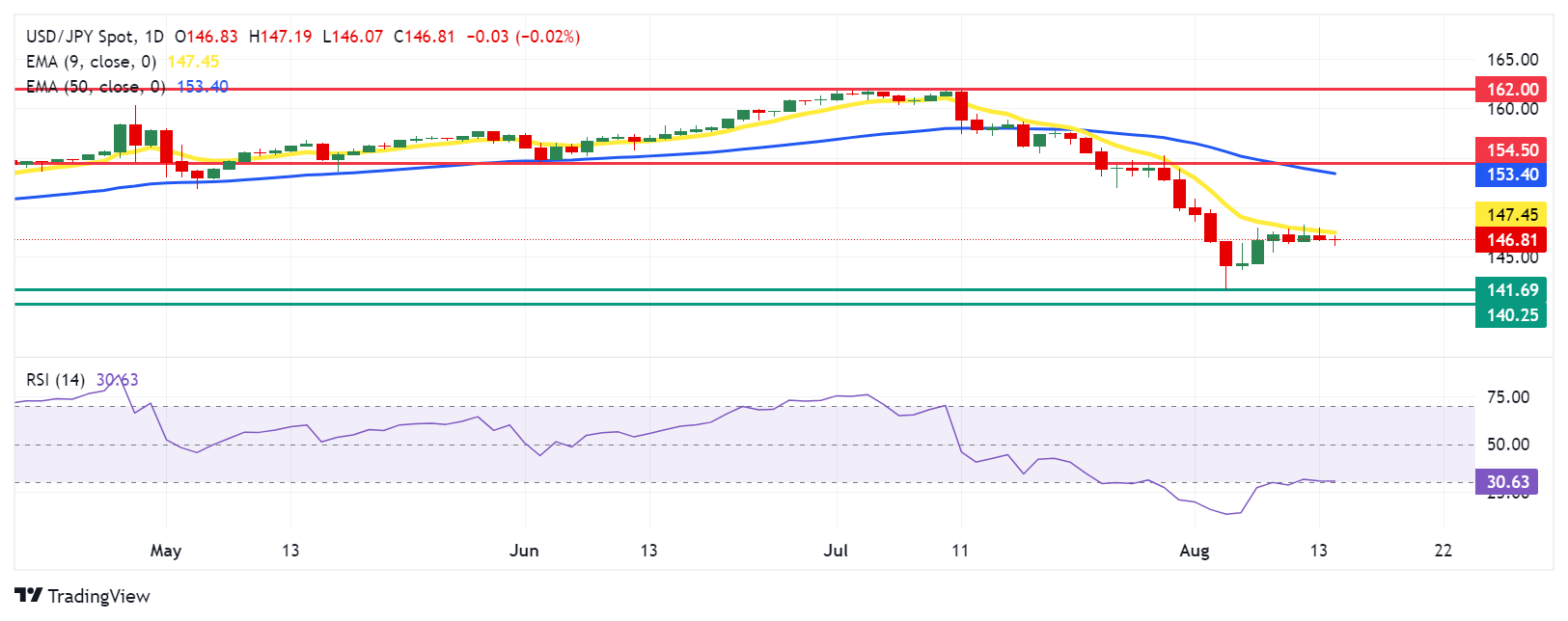- The Japanese Yen trims its intraday gains despite a hawkish sentiment surrounding the BoJ.
- Japan's parliament will hold a special session to discuss the BoJ interest rate hike last month.
- Downbeat US PPI data have decreased the odds of a larger Fed rate cut in September.
The Japanese Yen (JPY) trims its daily gains on Wednesday despite the rising expectations of the Bank of Japan (BoJ) hiking rates again in 2024. Japan's parliament is scheduled to hold a special session on August 23 to discuss the Bank of Japan's (BoJ) decision to raise interest rates last month. BoJ Governor Kazuo Ueda is expected to attend the session, according to government sources cited by Reuters.
The safe-haven flows might have contributed support for the Yen amid rising geopolitical tensions in the Middle East. The BBC reported on Tuesday that the United States sent a guided missile submarine to the Middle East. Additionally, Israeli forces continued their operations near Khan Younis in southern Gaza on Monday. CBC News reported that Palestinian medics indicated Israeli military strikes on Khan Younis on Monday resulted in the deaths of at least 18 people.
The US Dollar holds its ground as Treasury yields edge higher at the time of writing. However, the Greenback faced challenges following lower-than-expected Producer Price Index (PPI) data from the United States (US) released on Tuesday. This has decreased the bets for the US Federal Reserve's (Fed) bigger interest rate cut in September. Investors will likely observe the US CPI inflation report on Wednesday, which could offer some hints about the Federal Reserve’s (Fed) interest rate cut path.
Daily Digest Market Movers: Japanese Yen appreciates due to rising odds of BoJ hiking rates again
- Japanese Prime Minister Fumio Kishida announced at a press conference on Wednesday that he will not seek re-election as the leader of the Liberal Democratic Party (LDP) in September. Kishida emphasized the need to combat Japan's deflation-prone economy by promoting wage and investment growth and achieving the goal of expanding Japan's GDP to ¥600 trillion.
- Rabobank's senior FX strategist, Jane Foley, observes that this week's series of US data releases, along with next week's Jackson Hole event, should provide the market with clearer insights into the potential responses of US policymakers. However, their main expectation is that the Fed will reduce rates by 25 basis points in September and likely cut them again before the end of the year.
- The US Producer Price Index (PPI) rose 2.2% YoY in July from 2.7% in June, falling short of the market expectation of 2.3%. Meanwhile, the PPI increased 0.1% MoM after rising by 0.2% in June. The Core PPI rose by 2.4% year-on-year in July, against the previous reading of 3.0%. The index fell short of an estimate of 2.7%. The Core PPI remained unchanged.
- On Tuesday, Atlanta Fed President Raphael Bostic stated that recent economic data has increased his confidence that the Fed can achieve its 2% inflation target. However, Bostic indicated that additional evidence is required before he would support a reduction in interest rates, according to Reuters.
- On Sunday, Federal Reserve Governor Michelle Bowman stated that she continues to see upside risks for inflation and ongoing strength in the labor market. Bowman suggested that the Federal Reserve may not be prepared to cut rates at its next meeting in September, according to Bloomberg.
- The Bank of Japan’s Summary of Opinions from the Monetary Policy Meeting on July 30 and 31 indicated that several members believe economic activity and prices are evolving as expected by the BoJ. They are aiming for a neutral rate of "at least around 1%" as a medium-term target.
- The minutes from the Bank of Japan's June meeting indicated that some members voiced concerns about rising import prices due to the recent decline in the JPY, which could present an upside risk to inflation. One member highlighted that cost-push inflation might exacerbate underlying inflation if it leads to increased inflation expectations and wage hikes.
Technical Analysis: USD/JPY hovers around 147.00 with an immediate barrier at nine-day EMA
USD/JPY trades around 146.80 on Wednesday. The daily chart analysis shows that the pair remains below the nine-day Exponential Moving Average (EMA), suggesting a bearish trend in the short term. Moreover, the 14-day Relative Strength Index (RSI) is positioned at the 30 level, suggesting a potential for a correction.
For support levels, the USD/JPY pair might test a seven-month low of 141.69, recorded on August 5, followed by a secondary support level at 140.25.
On the upside, the pair could face immediate resistance at the nine-day EMA around 147.45. A breakout above this level might reduce bearish momentum and enable the pair to approach the 50-day EMA at 153.40, with the potential to test the resistance level of 154.50, where previous support has now turned into resistance.
USD/JPY: Daily Chart
Japanese Yen PRICE Today
The table below shows the percentage change of Japanese Yen (JPY) against listed major currencies today. Japanese Yen was the weakest against the Swiss Franc.
| USD | EUR | GBP | JPY | CAD | AUD | NZD | CHF | |
|---|---|---|---|---|---|---|---|---|
| USD | -0.20% | 0.16% | 0.25% | 0.04% | 0.04% | 1.19% | -0.30% | |
| EUR | 0.20% | 0.36% | 0.44% | 0.23% | 0.32% | 1.37% | -0.10% | |
| GBP | -0.16% | -0.36% | 0.15% | -0.11% | -0.05% | 1.03% | -0.43% | |
| JPY | -0.25% | -0.44% | -0.15% | -0.20% | -0.17% | 0.91% | -0.51% | |
| CAD | -0.04% | -0.23% | 0.11% | 0.20% | 0.03% | 1.13% | -0.30% | |
| AUD | -0.04% | -0.32% | 0.05% | 0.17% | -0.03% | 1.06% | -0.38% | |
| NZD | -1.19% | -1.37% | -1.03% | -0.91% | -1.13% | -1.06% | -1.42% | |
| CHF | 0.30% | 0.10% | 0.43% | 0.51% | 0.30% | 0.38% | 1.42% |
The heat map shows percentage changes of major currencies against each other. The base currency is picked from the left column, while the quote currency is picked from the top row. For example, if you pick the Japanese Yen from the left column and move along the horizontal line to the US Dollar, the percentage change displayed in the box will represent JPY (base)/USD (quote).
Japanese Yen FAQs
The Japanese Yen (JPY) is one of the world’s most traded currencies. Its value is broadly determined by the performance of the Japanese economy, but more specifically by the Bank of Japan’s policy, the differential between Japanese and US bond yields, or risk sentiment among traders, among other factors.
One of the Bank of Japan’s mandates is currency control, so its moves are key for the Yen. The BoJ has directly intervened in currency markets sometimes, generally to lower the value of the Yen, although it refrains from doing it often due to political concerns of its main trading partners. The current BoJ ultra-loose monetary policy, based on massive stimulus to the economy, has caused the Yen to depreciate against its main currency peers. This process has exacerbated more recently due to an increasing policy divergence between the Bank of Japan and other main central banks, which have opted to increase interest rates sharply to fight decades-high levels of inflation.
The BoJ’s stance of sticking to ultra-loose monetary policy has led to a widening policy divergence with other central banks, particularly with the US Federal Reserve. This supports a widening of the differential between the 10-year US and Japanese bonds, which favors the US Dollar against the Japanese Yen.
The Japanese Yen is often seen as a safe-haven investment. This means that in times of market stress, investors are more likely to put their money in the Japanese currency due to its supposed reliability and stability. Turbulent times are likely to strengthen the Yen’s value against other currencies seen as more risky to invest in.
Information on these pages contains forward-looking statements that involve risks and uncertainties. Markets and instruments profiled on this page are for informational purposes only and should not in any way come across as a recommendation to buy or sell in these assets. You should do your own thorough research before making any investment decisions. FXStreet does not in any way guarantee that this information is free from mistakes, errors, or material misstatements. It also does not guarantee that this information is of a timely nature. Investing in Open Markets involves a great deal of risk, including the loss of all or a portion of your investment, as well as emotional distress. All risks, losses and costs associated with investing, including total loss of principal, are your responsibility. The views and opinions expressed in this article are those of the authors and do not necessarily reflect the official policy or position of FXStreet nor its advertisers. The author will not be held responsible for information that is found at the end of links posted on this page.
If not otherwise explicitly mentioned in the body of the article, at the time of writing, the author has no position in any stock mentioned in this article and no business relationship with any company mentioned. The author has not received compensation for writing this article, other than from FXStreet.
FXStreet and the author do not provide personalized recommendations. The author makes no representations as to the accuracy, completeness, or suitability of this information. FXStreet and the author will not be liable for any errors, omissions or any losses, injuries or damages arising from this information and its display or use. Errors and omissions excepted.
The author and FXStreet are not registered investment advisors and nothing in this article is intended to be investment advice.
Recommended content
Editors’ Picks

EUR/USD under pressure near 1.0350 after mixed sentiment data
EUR/USD remains in the negative territory near 1.0350 in the European session on Tuesday, erasing a portion of Monday's gains. The pair is undermined by risk aversion and the US Dollar demand, fuelled by US President Trump's tariff threats, and mixed sentiment data.

GBP/USD drops to 1.2250 area on broad USD strength
GBP/USD stays under bearish pressure and trades deep in the red near 1.2250 on Tuesday as the USD gathers strength following US President Trump's tariff threats. The data from the UK showed that the ILO Unemployment Rate edged higher to 4.4% in the three months to November.

Gold price eases from over two-month top on stronger USD, positive risk tone
Gold price (XAU/USD) retreats slightly after touching its highest level since November 6 during the early European session on Tuesday and currently trades just below the $2,725 area, still up over 0.50% for the day.

Bitcoin fails to sustain the $109K mark after Trump’s inauguration
Bitcoin’s price steadies above the $102,000 mark on Tuesday after reaching a new all-time high of $109,588 the previous day. Santiment’s data shows that BTC prices quickly corrected, as social media showed major greed and FOMO among the traders in Bitcoin after President Donald Trump’s inauguration.

Five keys to trading Trump 2.0 with Gold, Stocks and the US Dollar Premium
"I have the best words" – one of Donald Trump's famous quotes represents one of the most significant shifts to trading during his time. Words from the president may have a more significant impact than economic data.

Trusted Broker Reviews for Smarter Trading
VERIFIED Discover in-depth reviews of reliable brokers. Compare features like spreads, leverage, and platforms. Find the perfect fit for your trading style, from CFDs to Forex pairs like EUR/USD and Gold.
